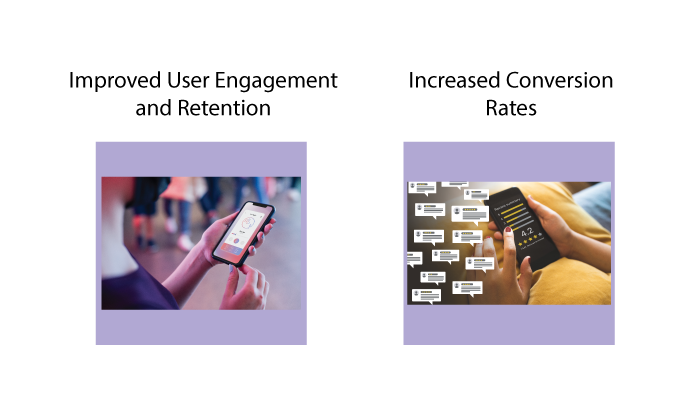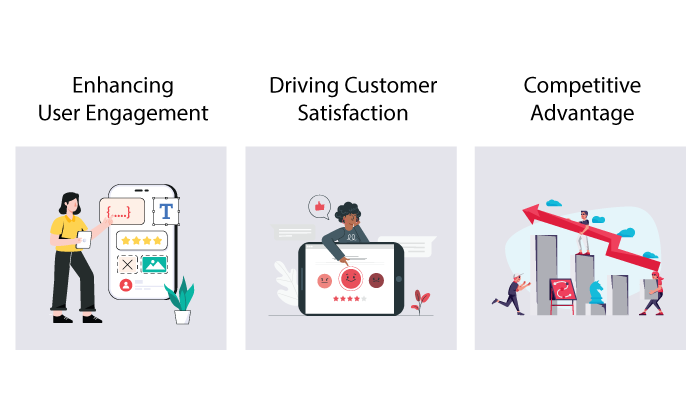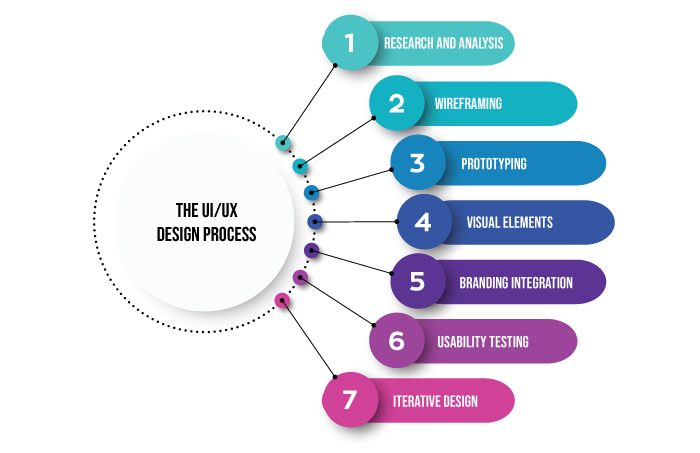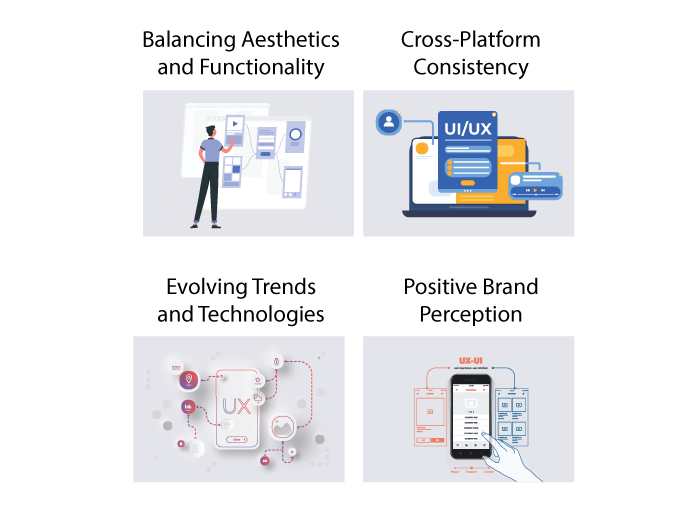Table of Contents
It goes without saying that UI/UX Design process is important part of any product whether it is a mobile app or website. And if you are someone who is interested in mobile app development, understanding how market leading firms design products is must.
So, if you are interested in learn just that, this blog is for you. Here, we shall be discussing all you need to know about designing process to convert a concept to reality. Along with this, we shall also be discussing the impact of design and process to create one.
Therefore, with this being said, let’s get right into it, starting with the basics, i.e. the definition of UI/UX Design.
Understanding UI/UX Design

The very first thing a person needs to understand is the concept of UI/UX designing itself. So, that’s what we will start with”
UI/UX design refers to the process of enhancing user satisfaction by improving the usability, accessibility, and overall experience of an application.
UI design focuses on the visual elements and layout, while UX design concentrates on the overall user journey, interaction, and emotions associated with using the app.
As such, it is an integral part of mobile app development as well as web and software solutions.
Now that you know what Designing is, it’s time to discuss it has on success of your mobile application.
The Impact of UI/UX Design on App Success

Every clients wants to know the use of product they are investing in. And that’s why they ask, what is the impact of UI/UX Design going to be on my mobile app? Well, the impact is huge.
Improved User Engagement and Retention
Research shows that apps with well-designed user interfaces have a 90% higher user retention rate compared to poorly designed ones. When users find an app visually appealing and intuitive, they are more likely to engage with it, explore its features, and continue using it over time.
Increased Conversion Rates
A well-crafted user experience can boost conversion rates by up to 200%. A seamless and enjoyable user experience encourages users to take the desired actions, such as making a purchase, signing up for a service, or sharing the app with others. Higher conversion rates translate into increased user acquisition and revenue generation.
The Significance of UI/UX Design

Well, the significance of design is great in the world of IT. Don’t we say, the first impression is last impression? Well, that is true on many levels. And here’s are some points that further prove the significance of design.
Enhancing User Engagement
User engagement is crucial for the success of any application. Intuitive and visually appealing interfaces keep users engaged, leading to higher user retention rates. When users find an app visually appealing, they are more likely to explore its features and continue using it over time.
Driving Customer Satisfaction
Customer satisfaction is paramount in building a loyal user base. A seamless and enjoyable user experience boosts customer satisfaction, fostering loyalty and positive word-of-mouth. By understanding user needs, preferences, and pain points, UI/UX designers can create solutions that address these aspects, resulting in satisfied users.
Competitive Advantage
In today’s crowded app marketplace, standing out from the competition is essential. Superior UI/UX design sets an app apart, attracting more users and increasing market share. A well-designed app creates a positive first impression, building credibility and trust among users, which can give a company a competitive edge.
The UI/UX Design Process

If you are someone wondering about the process used to create market leading UI/UX design by leading product design companies, well, wonder no more.
In this section of the blog, we shall be going through the step vice process of UI/UX Designing. Therefore, with this being said, let’s get right into it, starting with:
1. Research and Analysis
The very first thing you need to do is conduct market research and analyse the different elements.
As such, it can be divided into two parts, namely:
- User research
- Competitors analysis
So, let’s discuss both of them one by one.
Starting with user research to create a user-centric design, UI/UX designers must conduct thorough research to understand the target audience.
Moreover, this involves gathering insights into user demographics, behaviors, needs, and preferences through surveys, interviews, and usability testing. User research helps identify pain points and opportunities for improvement.
Moving on to the competitor analysis part; Analysing competitors’ UI/UX strategies is essential for staying relevant and identifying industry trends.
By examining what competitors are doing right and wrong, UI/UX designers can gain valuable insights to inform their design decisions and offer a unique and competitive user experience.
With this out of the way, it’s time to deal with wireframing and then prototyping.
2. Wireframing
Wireframing involves creating low-fidelity sketches or digital blueprints that outline the structure and functionality of the application.
It serves as a visual guide, helping designers and stakeholders understand the app’s layout, content hierarchy, and user flow.
Moreover, wireframes allow for early-stage feedback and iteration before investing significant resources in the design.
3. Prototyping
Once we are done with the wireframing process for UI/UX designing, it’s time to create prototype.
Prototyping brings wireframes to life by developing interactive mockups that simulate user interactions.
As such, prototypes allow designers to test the app’s usability, gather user feedback, and identify areas for improvement.
By iterating and refining the prototype, UI/UX designers can ensure a smooth and intuitive user experience.
4. Visual Elements
UI design focuses on the visual elements of the app, including color schemes, typography, icons, and images.
These elements contribute to creating a visually cohesive and aesthetically pleasing interface.
Therefore, carefully selecting visual elements that align with the target audience and the app’s purpose can evoke positive emotions and enhance the overall user experience.
5. Branding Integration
Incorporating the client’s brand identity into the design is essential for maintaining consistency across all touchpoints.
By incorporating brand colors, fonts, and logo design, UI/UX designers create a seamless brand experience that aligns with the app’s visual design, reinforcing brand recognition and trust.
6. Usability Testing
It’s important to test the product after it’s developed and that’s what we shall be doing in this step.
Usability testing involves observing real users as they interact with the app to evaluate its ease of use.
By conducting usability tests, UI/UX designers can identify pain points, understand user behavior, and gather valuable feedback for improvement.
Usability testing helps ensure that the final product meets users’ needs and expectations. And with this out of the way, let’s iterate the design.
7. Iterative Design
For those who don’t know, Iterative design is a cyclical process that involves incorporating user feedback and continuously refining the design through multiple iterations.
By iterating on the design, UI/UX designers can address user concerns, improve usability, and create a more user-centric experience. This process is crucial in achieving an optimal UI/UX design.
With this, we are done with our UI/UX or as some people call it, front-end designing process. Now, it is time to discuss some of the challenges that you might face in the process in next section of the blog.
Challenges in UI/UX Design

Even if you are working with the best IT development agency like weappit, you are bond to come across some challenges that might cause issues.
Therefore, it’s a good idea to learn about these challenges beforehand. So, some of the challenge that you might face in UI/UX designing are, as mentioned below:
· Balancing Aesthetics and Functionality
One of the main challenges in UI/UX design is striking the right balance between visually appealing design and functional elements.
While aesthetics are important for creating an engaging interface, the app must also provide a seamless user experience. UI/UX Designers need to ensure that functionality is not compromised by prioritizing aesthetics.
· Cross-Platform Consistency
In a multi-device world, maintaining cross-platform consistency is crucial.
UI/UX designers must ensure that the app’s design remains consistent across different platforms and devices, such as smartphones, tablets, and desktops.
Consistency fosters familiarity and usability, allowing users to seamlessly transition between devices without confusion.
· Evolving Trends and Technologies
UI/UX designers must stay updated with the latest UI/UX trends, emerging technologies, and design principles.
They need to adapt their designs to accommodate new technologies like voice assistants, augmented reality (AR), and virtual reality (VR).
Embracing emerging trends and technologies enables designers to create modern and innovative experiences for users.
· Positive Brand Perception
88% of users are less likely to return to a website or app after a bad experience. UI/UX design plays a significant role in shaping users’ perception of a brand.
A well-designed app creates a positive first impression, builds credibility, and fosters trust in the brand. Positive brand perception leads to increased customer loyalty and advocacy.
Conclusion
UI/UX design plays a vital role in the success of development companies by creating visually appealing, intuitive, and user-friendly applications.
The journey from concept to reality involves thorough research, wireframing, prototyping,
visual design, user testing, and iterative improvements.
By overcoming challenges and prioritizing the user experience, companies can develop apps that stand out in the competitive market, driving customer satisfaction and ultimately achieving business success.
Therefore, if you are someone who wants to design a market leading product, it’s highly recommended that you consult an UI/UX Designing company.
FAQ
UI design (User Interface design) focuses on the visual aspects and layout of an application, including color schemes, typography, icons, and images. UX design (User Experience design) encompasses the overall user journey, interactions, and emotions associated with using the app, ensuring a seamless and enjoyable user experience.
UI/UX design plays a crucial role in app success. It enhances user engagement, driving higher user retention rates. A well-designed user experience boosts customer satisfaction, fostering loyalty and positive word-of-mouth. It also provides a competitive advantage, attracting more users and increasing market share.
The UI/UX design process involves several steps:
- Research and Analysis: Understanding the target audience and analyzing competitors’ strategies.
- Wireframing and Prototyping: Creating low-fidelity sketches and interactive mockups to outline the app’s structure and functionality.
- Visual Design: Selecting visual elements and incorporating brand identity into the design.
- User Testing and Iteration: Conducting usability testing and incorporating user feedback to refine the design.
Some common challenges in UI/UX design include balancing aesthetics and functionality, maintaining cross-platform consistency, and keeping up with evolving trends and technologies. Designers must strike a balance between visual appeal and usability, ensure consistency across different devices, and adapt to emerging technologies.
Well-designed user interfaces lead to higher user engagement and retention rates. When users find an app visually appealing and intuitive, they are more likely to explore its features and continue using it over time. Research indicates that apps with superior UI have a 90% higher user retention rate compared to poorly designed apps.
Yes, a well-crafted user experience can significantly increase conversion rates. When users have a seamless and enjoyable experience with an app, they are more likely to take desired actions, such as making a purchase or signing up for a service. Studies show that effective UI/UX design can boost conversion rates by up to 200%.
UI/UX design plays a crucial role in shaping users’ perception of a brand. A well-designed app creates a positive first impression, building credibility and trust in the brand. On the other hand, a poorly designed app can lead to negative brand perception, resulting in users being less likely to return.
Yes, investing in UI/UX design is essential for development companies. In today’s competitive market, a well-designed user experience sets an app apart, attracting more users and increasing market share. It enhances user satisfaction, drives customer loyalty, and ultimately contributes to the success of the app and the company as a whole.





No Comments
Comments are closed.